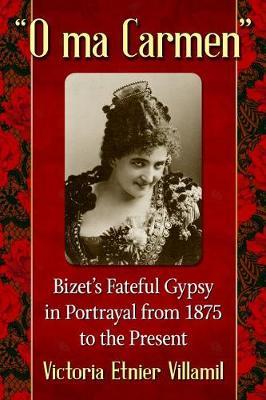
217 pp, McFarland ISBN 978-1-4766-6324-1
“ O MA CARMEN” Bizet’s Fateful Gypsy in Portrayal from 1875 to the Present by Victoria Etnier Villamil

217 pp, McFarland ISBN 978-1-4766-6324-1
Click here to order the book or here
“Qu’est-ce que c’est?” (What is it?) mezzo-soprano Célestine Galli-Marié asked when offered the title role in the 1875 premier of Bizet’s new opera, Carmen. She was only the first in a long line of performers to ask. In the 140+ years since, each singer has crafted her own portrayal of the inscrutable Gypsy. The famous soprano Geraldine Farrar wrote: “Each one of us probably sees something that the others have not seen—or thinks she does—and that ‘something’ is her individual Carmen.”
In twelve chapters Victoria Etnier Villamil, a former soprano who also sang Carmen once, explores the history of operatic portrayals of Bizet’s elusive enchantress, tracing the development of vocal and dramatic interpretations from generation to generation around the globe. From Galli-Marié to Elena Garanca and every Carmen in between the author analyzes the various interpretations using her own critical ear and eye and contemporary reviews. Villamil’s “Carmen journey” is a fascinating and a revealing one. The book is an easy and interesting read and on many an occasion I discovered several patches of info totally new to me whether about the actual character of Carmen or the artist interpreting it. Villamil did her research thoroughly yet a few mistakes crept in the narrative. Lily Djanel was a Walloon soprano and not Flemish, Mariette Mazarin was not Belgian but French.. Villamil also gives Carmen’s Dutch premiere in 1887 yet it was already performed a year earlier.
Also thorough editing would have been able to get rid of a few regrettably annoying spelling mistakes such as ‘Standingm still’ (pg. 11), ‘who didn’t made’ (pg.77), it is Peter Diamand and not Diamond (pg.138), it is Henri Saint-Cricq and not Saint-Criege (pg.178), the Austrian CD label is called Preiser and not Presier (pg. 180) or Lebendige Vergangenheit and not Verganenheit (pg. 181), It is Jessye Norman and not Jesseye (pg.181), it is Giulietta Simionato and not Giuetta (pg. 182) , it is Léon Carvalho and not Carvahlo (pg. 210), it is André Cluytens and not Cluytans (pg. 211), it is Lotfi Mansouri and not Lofti (pg.214), it is Marguerite Sylva and not Margeurite (pg. 216) etc. Also in the discography on page 187 Anne Sofie von Otter is indexed as “Sofie von Otter, Anne”.
The appendices include a fine chronology of important premieres and significant performances, a videography and an index. There’s also a fairly complete discography of Carmen recordings on CD. To my regret LP only releases are not dealt with, nor solo recordings of Carmen’s arias (think the early releases of the French magazine L’avant-scène). These would have added greatly to the value of the book. Photos of the most important Carmens are included.
All in all anyone with an interest in the history of singing, performance practice or the opera itself will find great pleasure in Villamil’s work. Recommended.
Rudi van den Bulck, October 2017